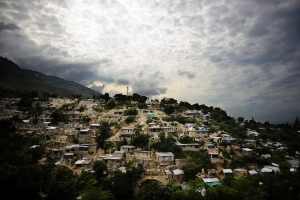
After decades of political violence, after being pounded by hurricanes and floods, and after the January 2010 earthquake, Haiti now faces a cholera epidemic that has so far defied all efforts to bring it under control—efforts made even more difficult by last week’s rioting over disputed election results. In the outbreak’s first 30 days, the disease claimed an estimated 2,000 lives. It started in central Haiti, many miles upstream from the tent cities around Port-au-Prince where more than 1 million displaced Haitians defecate, wash, and eat in overcrowded, unsanitary conditions. But no epidemic of cholera stays local for long: cases have already been reported not only in every district but also in the Dominican Republic and Florida.
There’s reason to fear that this outbreak is, in the words of a colleague who’s an expert on the disease, “not your grandmother’s cholera.” The strain described by epidemiologists as “an El Tor biotype of Vibrio cholerae serogroup 01” seems especially virulent and hard to slow down. In fact, if the long history of a similar El Tor strain in Bangladesh is any indication, the disease could become endemic in Haiti. That threat makes it all the more urgent for the world to renew its relief efforts in Haiti—and to resist the temptation to write off the country’s 10 million people as beyond hope.
The No. 1 priority is to deliver quality care to the sick. Although cholera’s profuse diarrhea can shrivel and kill a healthy adult in hours, early detection and expert care can save virtually anyone who contracts the disease. And in our opinion, proper care includes aggressive use of antibiotics. Some authorities recommend that treatment consist only of oral rehydration or, failing that, intravenous resuscitation. Antibiotic therapy is currently recommended only for the most severe cases, because of cost and for fear of encouraging the growth of drug-resistant microbes. In the case of Haiti’s present outbreak, we think this is a mistake. Antibiotics can shorten the course of illness, decrease the volume of diarrhea, and reduce the time that patients shed contagious organisms—all of which helps prevent deaths and limit transmission.
Oral cholera vaccines are another powerful tool against the disease, protecting as many as 90 percent of people who have been fully vaccinated. Some say this can’t work in Haiti, since at least two doses are recommended; others argue the vaccine is too expensive or in short supply. But we’ve already accomplished an even tougher feat by completing a three-course dose of the cervical cancer vaccine in Haiti for 76 percent of the girls we enrolled—about twice the rate for similar programs in the United States—and the earthquake struck between the first and second doses. Vaccines were not recommended during last year’s cholera outbreak in Zimbabwe, and 4,000 people died in a single year. With half that number of deaths in just one month, Haiti can’t afford not to consider vaccination. And the rest of the world can’t afford not to have a global vaccine stockpile.
But those fixes, no matter how effective they may prove, are only stopgaps. Haiti’s chronic water-supply and sanitation problems made outbreaks of waterborne disease inevitable even prior to the quake. Nevertheless, the United States and other governments slowed the flow of aid to the Haitian public sector between 2000 and 2004 in order to put pressure on then-president Jean-Bertrand Aristide. The affected programs included a loan to strengthen the water systems in two cities, one of which (St-Marc) was where the first cholera cases appeared in October. Work on these projects began only last year. It was no surprise, then, that Haiti was ranked last out of 147 countries for water security in 2002. To offset at least some of the damage, the U.S. government has just allocated $57 million for cholera-relief efforts in Haiti.
Haiti is not beyond hope. Partners In Health and its sister organization, Zanmi Lasante, have seen some successes in our many years there. In central Haiti, working with Haitian health authorities, we’ve built hospitals and clinics that registered some 2 million patient visits last year. Those patients include the beneficiaries of Haiti’s first AIDS-treatment program, launched more than a dozen years ago. The outcomes bear us out: over the past 15 years the number of new AIDS infections in Haiti has dropped by half.
Cholera demands a similar approach: fully integrated prevention and care, using all the tools available and raising our goals. Twelve years ago we argued that AIDS treatment using antiretroviral therapy was possible even in rural Haiti—and the results have justified that approach. The Haitian cholera epidemic exposes the fallacy of setting goals based on a country’s GDP. Pathogens like HIV, cholera, and dengue move within a complex web of global social connections, binding the richest and the poorest countries together in vulnerability. But while those microbes jet around the world, their remedies remain stuck in customs.
There’s no excuse for allowing Haiti’s cholera disaster to escalate. We already have preventive measures—from improved sanitation to vaccines—and effective treatments: rehydration, replacement of electrolytes, and antibiotics. We must move swiftly, aggressively, and together. If we insist that prevention and care are complementary, and we draw on any and all means available globally, we can beat this emergency—and whatever problem comes next.
Farmer is chairman of the Department of Global Health and Social Medicine at Harvard Medical School. Réjouit is codirector of women’s health for Zanmi Lasante, the Haitian branch of partners in health. Both have worked in rural Haiti for many years.